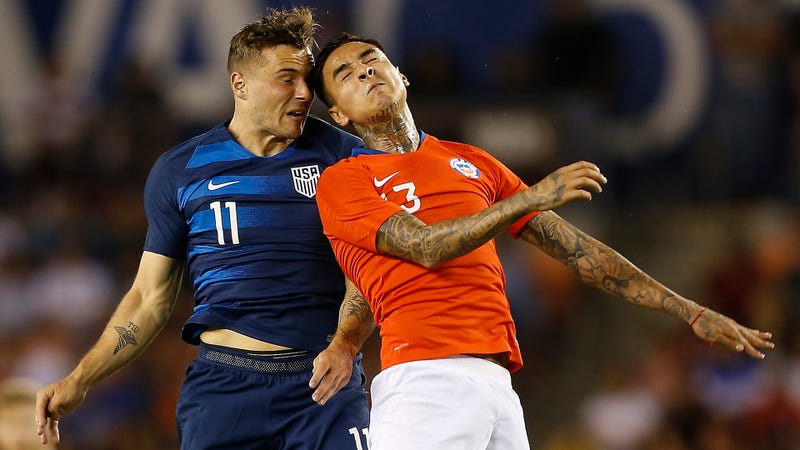Even American Soccer Fandom Is Plagued By Pay-To-Play


If you had to point out a single factor that most contributes to the U.S.’s stunted development as a soccer nation, you could make a good case for pay-to-play as the culprit. Pay-to-play is the system that sections off the best youth coaching and competition and reserves it only for those who can afford to pay for it. It is, as Jurgen Klinsmann famously once said, the upside-down pyramid that conditions everything else in American soccer. And the scourge of requiring exorbitant payment for access to the game is only spreading.
Take last night’s U.S.-Chile friendly, played in Houston, Texas. The match was no blockbuster, as neither team qualified for last summer’s World Cup. Nor was it all that tantalizing a spectacle even for USMNT heads: the stadium did not sell out, and I think of all the soccer fiends on the Deadspin staff, only Lauren Theisen actually watched the game, and mainly because she was working the night shift and had to keep track of just about the only sporting event going on. (I personally haven’t been able to stomach more than a few minutes of passive viewing of any post-Trinidad & Tobago USMNT efforts, mostly out of lingering disappointment and jadedness.)
And yet as the Guardian points out, tickets to last night’s show in Houston were outrageously expensive. “Online prices ranged from $42.85 to $320.20 including fees,” the article says, “with a $600 ‘ultimate fan ticket’ available that offered limited behind-the-scenes access.” Meanwhile, across the pond the day before, the reigning World Cup winners, France, hosted Iceland in a real-deal, competitive match for qualification for the 2020 Euros. The French charged their fans between $28 to $122 to see the game in person.
The Guardian article further explains how cranked-up prices for soccer matches are the norm in this country. For years, U.S. Soccer has made it an express goal to steadily hike ticket prices for USMNT home games while holding those matches in increasingly smaller venues to juice the bottom line:
Advertisement
On top of that, the article notes how age-based stadium discounts, common in European soccer scene, are exceedingly rare in MLS (and in other American pro sports for that matter). Lest you think U.S. Soccer is the only one benefitting from ripping off stateside soccer lovers, recall the U.S.-hosted 2016 edition of South America’s Copa América with its half-empty stadiums, sky-high ticket prices, and the record revenues everyone was able to bring home in spite of it all.
This is no good. Between the arm and four toes it costs to watch the USMNT play even a meaningless friendly in person from a decent vantage point, the deluxe cable package and attendant streaming-only add-on service needed to watch all the best European soccer on TV in this paywalled hell we’re living in, and the prohibitive time and money parents with promising youth players must commit to make sure their little Zachs and Victorias have a real opportunity to develop and display their talents to the fullest extent possible, it’s becoming increasingly clear that soccer is only becoming more socially and economically stratified. Playing high-level soccer, watching high-level soccer, and attending high-level soccer matches in person have long been the purview of the country’s privileged class. The rising costs associated with each of these dimensions should only strengthen the status quo even further. Doing all this at such a critical juncture in the sport’s history in this country, when various factors have made the game more popular than ever and everything should be focused on making soccer more open and accessible for everyone, is a heinous redirection of what looked like an encouraging upward trend in soccer’s domestic growth.
Yesterday’s match itself provided a good glimpse at what’s at stake. Predictably, Christian Pulisic—already America’s most gifted player ever who had to leave America to find a soccer culture better equipped to develop a talent as stratospheric as his—was the impetus. It wasn’t during the match itself, though Pulisic did make a brief but memorable star turn by scoring the U.S.’s sole goal of the night. Instead, the revealing moment happened well before kick-off, when Pulisic made his way down the stadium tunnel and acknowledged a couple young boys lining the hallway, who were overwhelmed with glee after seeing their idol up close:
Advertisement
U.S. Soccer and America’s soccer culture as a whole should be doing everything in their power to create more moments like that one, to make Pulisic more famous, his matches for both club and country more readily available to watch on TV and online, his physical presence more easy to feel first-hand with an in-person stadium experience, so that even more young boys will recognize him, obsess over him, be thrown into raptures at the prospect of meeting him, and, most crucially, feel like there is no obstacle blocking their path from becoming the next Pulisic other than their own talent and drive.
Unfortunately, that is not currently the case. By charging fans young and old stupid prices to go and see Pulisic and Co. play, let alone the monumental costs levied on parents in training youth players of the highest caliber, it appears the country is instead willingly throwing itself in exactly the opposite direction.
Source: Read Full Article